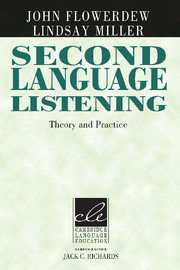Series editor's preface
Published online by Cambridge University Press: 04 February 2010
Summary
Acquiring good listening and speaking skills in English is the main concern of many second and foreign language learners, and today's English teacher needs to be well versed in current approaches to the teaching of the aural/oral skills. Second language listening, relatively ignored for many years within applied linguistics, has today come into its own. Although still somewhat neglected in second language acquisition research, listening now plays a more central role in language teaching. University entrance exams, school leaving tests, and other examinations have begun to include a listening component, an acknowledgment that listening ability is an important aspect of second language proficiency.
The nature of listening comprehension is also now better understood. Earlier views of listening saw it as the mastery of discrete skills or micro skills, which formed the focus of teaching and testing. A skills approach focused on such things as discriminating sounds in words (especially phonemic contrasts), deducing the meaning of unfamiliar words, predicting content, differentiating between fact and opinion, and noting contradictions, inadequate information, and ambiguities.
The changed status of listening in recent years was partly prompted by Krashen's emphasis on the role of comprehension and comprehensible input in triggering language development. In the 1980s and 1990s, applied linguists also began to borrow new theoretical models of comprehension from the field of cognitive psychology. It was from this source that the distinction between bottom-up processing and top-down processing was derived – a distinction that led to an awareness of the importance of background knowledge and schema in comprehension. Listeners were viewed as actively involved in constructing meaning based on expectations, inferences, intentions, prior knowledge, and selective processing of the input.
- Type
- Chapter
- Information
- Second Language ListeningTheory and Practice, pp. ix - xPublisher: Cambridge University PressPrint publication year: 2005



